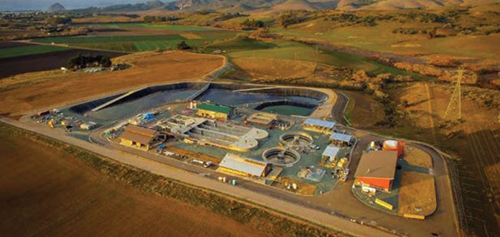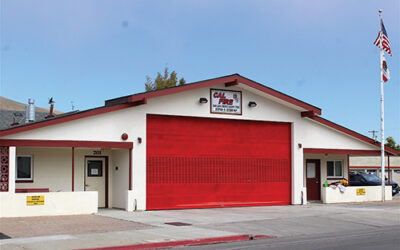Aerial photo shows the Los Osos Wastewater Treatment Plant shortly after being completed in 2016. File photo
San Luis Obispo County Supervisors approved a contract to install some new equipment at the Los Osos Wastewater Treatment Plant; gizmos designed to better control the pressure inside the plant’s discharge lines and extend their useful lives.
Supervisors approved a $187,000 contract with electrical contractors, Electricraft, Inc., of San Luis Obispo to install so-called “variable frequency drives” at the plant.
Electricraft was the lowest of four bidders for the job of wiring in the devices which allow the plant’s four main, 100-horsepower pumps to run at a speed somewhat below 100% all the time.
EBN asked Blythe for a simple explanation of what these VFDs do and why they are needed.
“The recycled water pumps,” he said, “are a critical part of the treatment process. Both repair and replacement are costly.
“Currently, the recycled water system in Los Osos operates at a high pressure that must be handled by pressure reducing valves at the end point of the systems. This high pressure can cause problems for recycled water users and the Broderson Leach Field.”
The County’s community sewer system included a recycling scheme that put in a huge leach field on the lower hillsides behind Broderson Avenue. The idea was to pipe the treated, recycled wastewater to the leach field and return it to the groundwater basin, where all of Los Osos’ drinking water currently comes from.
The county has also signed agreement with a few farmers in Los Osos Valley to accept treated wastewater for irrigation, running a pipe from the plant out Clark Valley Road. The project’s Coastal Development Permit from the Coastal Commission requires a certain amount of the wastewater to be re-used for agriculture.
Blythe added that the demand on this water isn’t steady. “Water demands by downstream users vary throughout the day and seasonally,” Blythe said. “With additional users scheduled to connect to receive water, greater recycled water fluctuations will occur.”
Like a child playing with a light switch, these pumps are going on and off all the time. “Recycled water pumps cycle on and off frequently,” Blythe said. “Running a pump away from its most efficient flow wastes energy and increases load and wear on the pumps, hastening pump and motor failures.”
It’s a little like turning your car’s engine off at every stop sign and turning it back on when the coast is clear to go. “Likewise, when any pump is started, costly electricity surges occur to start rotating the motor and pump,” Blythe said. “Adding Variable Speed Drives will allow the pumps to vary their speed to maintain more constant pressures and at a more reasonable pressure. System pressures will also determine when a pump turns on or off, so pumps operate longer before needing to be turned off and closer to best efficiency flows because the speed of the pump varies.
“This will save energy and reduce pump failures. The VFDs will maintain more constant pressure in the distribution system, and reduce the frequency of pump starting and stopping, saving energy that results in increased pump life span.”
As a side note, a Google search for the cost of 100 hp pumps lists them as running between $7,000 and $120,000.
The plant delivers treated, re-usable waste water to “urban, agricultural, and leach field sites,” the report said. “These recycled water customers experience very high water pressure that must be regulated at the point of discharge to prevent damage to equipment and property.”
Electricraft will be charged with wiring the new regulators into electrical panels located in the plant’s control room.
Electricraft’s bid was 6.1% below the engineer’s estimate from the County and lower than three other companies bid. The others were: Alpha Electrical Services, Inc., at $190,000; Smith Mechanical-Electrical-Plumbing at $226,000; and Taft Electric Company at $313,000.
The contract includes an $18,000 contingency bringing the total contract amount to potentially, $206,000. The County anticipates another $49,000 in “project support costs” bringing the overall project’s expected cost up to $255,000.
According to Blythe’s report, the County has $600,000 set aside for the project out of the $1.5 trillion American Rescue Plan Act funding that was passed in 2021 to address the COVID-19 Pandemic impacts to the nation.



